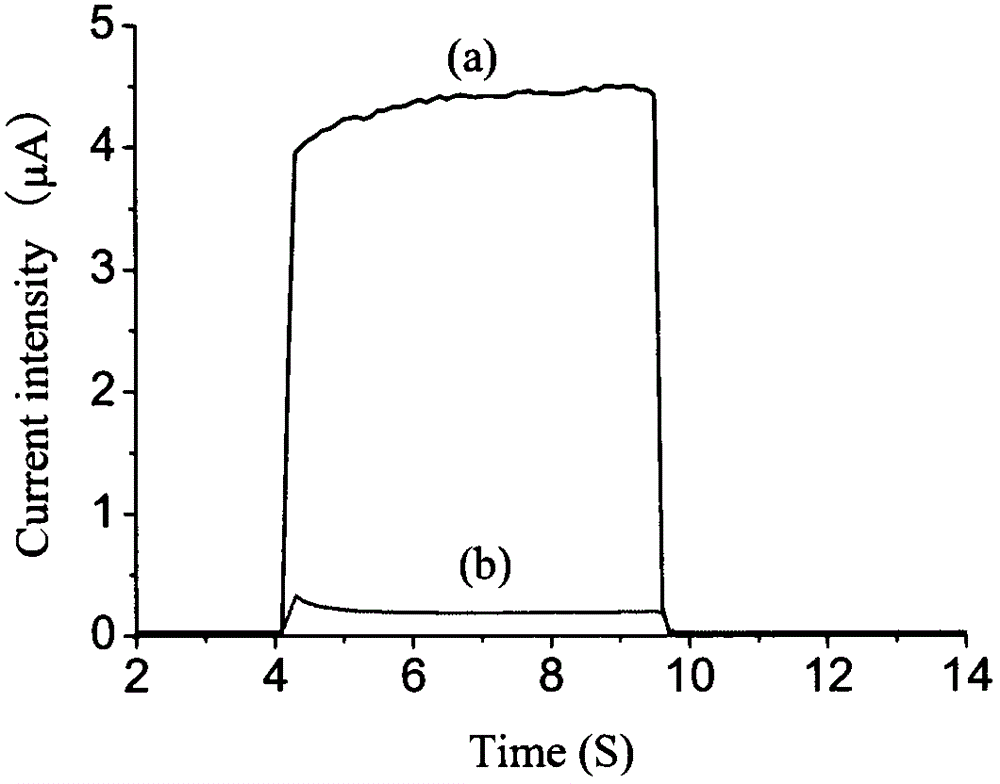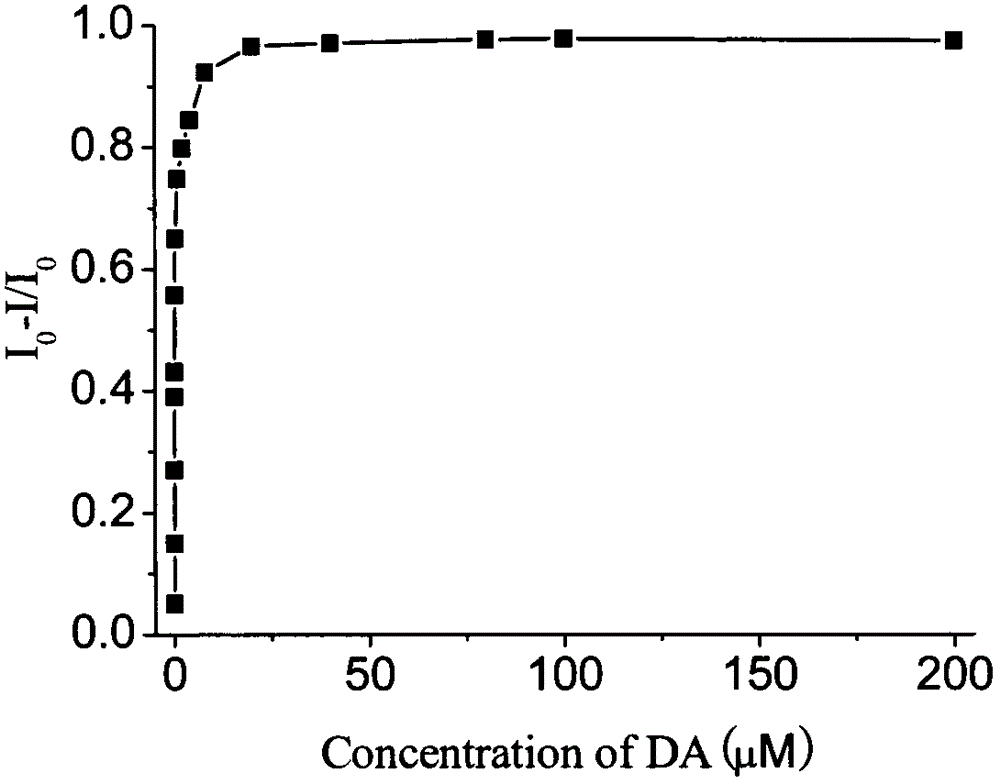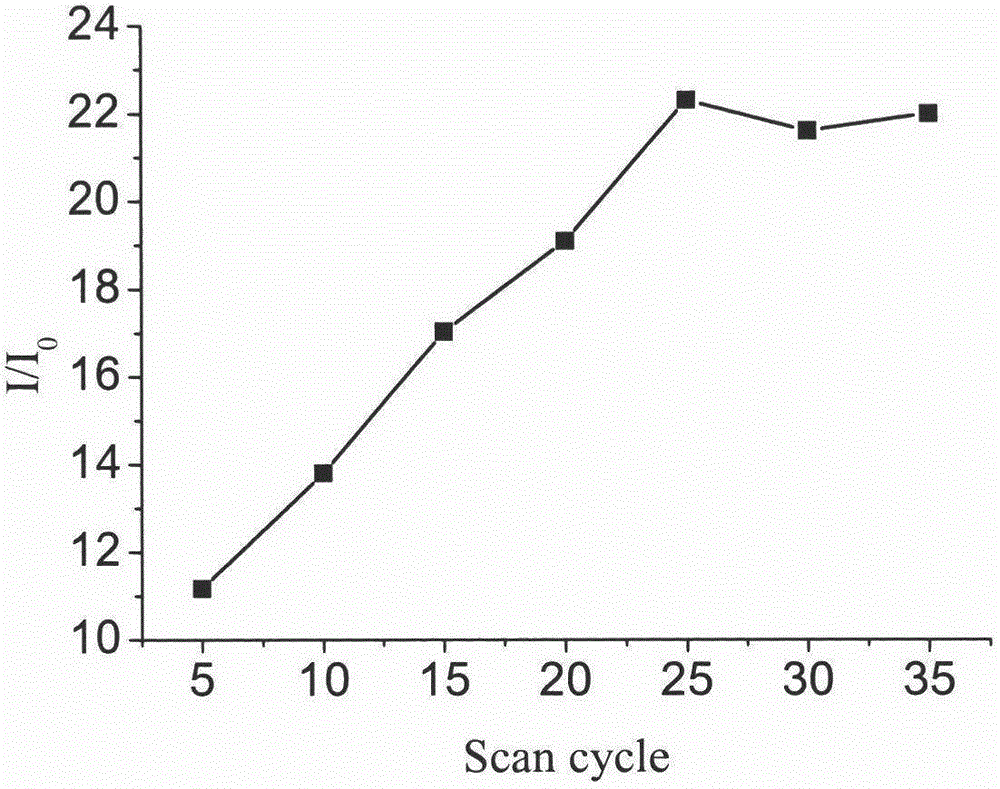Nano photoelectronchemical sensor for detecting dopamine with high sensitivity
A sensitive detection, photoelectrochemical technology, applied in the field of analysis and detection, to achieve the effect of good selectivity and high sensitivity
- Summary
- Abstract
- Description
- Claims
- Application Information
AI Technical Summary
Problems solved by technology
Method used
Image
Examples
Embodiment 1
[0018] a. 250μL of thioglycolic acid solution and 50ml of 0.02mol / L Cd(ClO 4 ) 2 After the solution is mixed, add 1mol / L NaOH solution to adjust the pH of the solution to 7, and after feeding high-purity nitrogen for 30 minutes, add 5ml of 0.1M NaOH solution 2 Se aqueous solution, continue to feed nitrogen gas and stir for 4 hours to obtain water-soluble CdSe nanomaterials;
[0019] b. Immerse the ITO glass sheet in a 2% PDDA polymer solution containing 2mol / L NaCl, rinse the surface with deionized water after 5 minutes, then immerse it in the water-soluble CdSe nanomaterial, and rinse it with deionized water after 5 minutes Clean the electrode surface. The prepared electrode can be stored at room temperature.
[0020] c. The prepared CdSe-modified electrode is used as a working electrode, immersed in an electrolyte solution composed of 0.1mol / L triethanolamine and 0.1mol / L phosphate buffer solution (pH=7.0), adding different concentrations of dopamine, first using Cyclic ...
Embodiment 2
[0022] a, 0.527g of cysteine hydrochloride and 50ml of 0.02mol / L CdCl 2 After the solution is mixed, add 1mol / L NaOH solution to adjust the pH of the solution to 11, and after passing high-purity nitrogen for 30 minutes, add 5ml of 0.1M NaOH solution 2 S aqueous solution, continue to feed nitrogen and stir for 4 hours to obtain water-soluble CdS nanomaterials;
[0023] b. Immerse the ITO glass piece in 2% PDDA polymer solution containing 2mol / LNaCl, rinse the surface with deionized water after 10 minutes, then immerse it in the water-soluble CdS nanomaterial, and wash it with deionized water after 10 minutes electrode surface. The above steps were repeated 5 times to prepare an electrode decorated with 5 layers of CdS nanomaterials. The fabricated electrodes were stored at room temperature.
[0024] c. The prepared CdS-modified electrode is used as a working electrode, immersed in an electrolyte solution composed of 0.05mol / L ascorbic acid and 0.1mol / L phosphate buffer so...
Embodiment 3
[0026] a, 0.588g of trisodium citrate dihydrate and 50ml of 0.02mol / L Cd(NO 3 ) 2 After the solution is mixed, add 1 mol / L NaOH solution to adjust the pH of the solution to 7.5; after passing high-purity nitrogen gas for 30 minutes, add 5 ml of 0.1M NaHTe aqueous solution, and continue stirring and reacting with nitrogen gas for 4 hours to obtain water-soluble CdTe nanomaterials;
[0027] b. Immerse the ITO glass sheet in 2% PDDA polymer aqueous solution containing 2mol / L NaCl, rinse the surface with deionized water after 8 minutes, and then immerse it in the water-soluble CdTe nanomaterial, rinse with deionized water after 10 minutes Clean the electrode surface. The above steps were repeated 5 times to prepare an electrode modified by 5 layers of CdTe nanomaterials. The prepared electrodes can be stored at room temperature.
[0028] c. The prepared CdTe-modified electrode is used as a working electrode, immersed in an electrolyte solution composed of 0.05 mol / L triethylami...
PUM
 Login to View More
Login to View More Abstract
Description
Claims
Application Information
 Login to View More
Login to View More - R&D
- Intellectual Property
- Life Sciences
- Materials
- Tech Scout
- Unparalleled Data Quality
- Higher Quality Content
- 60% Fewer Hallucinations
Browse by: Latest US Patents, China's latest patents, Technical Efficacy Thesaurus, Application Domain, Technology Topic, Popular Technical Reports.
© 2025 PatSnap. All rights reserved.Legal|Privacy policy|Modern Slavery Act Transparency Statement|Sitemap|About US| Contact US: help@patsnap.com



